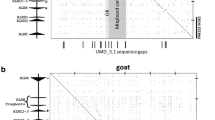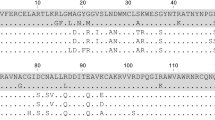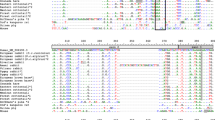Abstract
The acidic granules of natural killer (NK) cells, T cells, mast cells, and neutrophils store large amounts of serine proteases. Functionally, these proteases are involved, e.g., in the induction of apoptosis, the recruitment of inflammatory cells, and the remodeling of extra-cellular matrix. Among the granule proteases are the phylogenetically related mast cell chymases, neutrophil cathepsin G, and T-cell granzymes (Gzm B to H and Gzm N), which share the characteristic absence of a Cys191–Cys220 bridge. The genes of these proteases are clustered in one locus, the mast cell chymase locus, in all previously investigated mammals. In this paper, we present a detailed analysis of the chymase locus in cattle (Bos taurus) and opossum (Monodelphis domestica). The gained information delineates the evolution of the chymase locus over more than 200 million years. Surprisingly, the cattle chymase locus contains two α-chymase and two cathepsin G genes where all other studied chymase loci have single genes. Moreover, the cattle locus holds at least four genes for duodenases, which are not found in other chymase loci. Interestingly, duodenases seem to have digestive rather than immune functions. In opossum, on the other hand, only two chymase locus-related genes have been identified. These two genes are not arranged in one locus, but appear to have been separated by a marsupial-specific chromosomal rearrangement. Phylogenetic analyses place one of the opossum genes firmly with mast cell α-chymases, which indicates that the α-chymase had already evolved as a separate, clearly identifiable gene before the separation of marsupials and placental mammals. In contrast, the second gene in opossum is positioned phylogenetically between granzymes, cathepsin G, and the duodenases. These genes, therefore, probably evolved as separate subfamilies after the separation of placental mammals from marsupials. In platypus, only one chymase locus-like sequence could be identified. This previously published “granzyme” does not cluster clearly with any of the chymase locus gene families, but shares the absence of the Cys191–Cys220 bridge with the other chymase locus proteases. These findings indicate that all chymase locus genes are derived from a single ancestor that was present more than 200 million years ago.





Similar content being viewed by others
Abbreviations
- aa:
-
amino acid
- BDMD:
-
duodenase
- EST:
-
expressed sequence tag
- Gzm:
-
granzyme
- mMCP:
-
mouse mast cell protease (protein)
- rMCP:
-
rat mast cell protease (protein)
- Mcpt :
-
mast cell protease (gene)
- nt:
-
nucleotide
- sim.:
-
similar
- corr:
-
corrected
References
Adkins RM, Gelke EL, Rowe D, Honeycutt RL (2001) Molecular phylogeny and divergence time estimates for major rodent groups: evidence from multiple genes. Mol Biol Evol 18:777–791
Arnason U, Gullberg A, Gretarsdottir S, Ursing B, Janke A (2000) The mitochondrial genome of the sperm whale and a new molecular reference for estimating eutherian divergence dates. J Mol Evol 50:569–578
Caputo A, James MN, Powers JC, Hudig D, Bleackley RC (1994) Conversion of the substrate specificity of mouse proteinase granzyme B. Nat Struct Biol 1:364–367
Caughey GH (2002) New developments in the genetics and activation of mast cell proteases. Mol Immunol 38:1353–1357
Caughey GH, Raymond WW, Wolters PJ (2000) Angiotensin II generation by mast cell alpha- and beta-chymases. Biochim Biophys Acta 1480:245–257
Cooper GM, Brudno M, Green ED, Batzoglou S, Sidow A (2003) Quantitative estimates of sequence divergence for comparative analyses of mammalian genomes. Genome Res 13:813–820
Cooper GM, Brudno M, Stone EA, Dubchak I, Batzoglou S, Sidow A (2004) Characterization of evolutionary rates and constraints in three mammalian genomes. Genome Res 14:539–548
Edwards KM, Kam CM, Powers JC, Trapani JA (1999) The human cytotoxic T cell granule serine protease granzyme H has chymotrypsin-like (chymase) activity and is taken up into cytoplasmic vesicles reminiscent of granzyme B-containing endosomes. J Biol Chem 274:30468–30473
Fang KC, Raymond WW, Blount JL, Caughey GH (1997) Dog mast cell alpha-chymase activates progelatinase B by cleaving the Phe88-Gln89 and Phe91-Glu92 bonds of the catalytic domain. J Biol Chem 272:25628–25635
Felsenstein J (1989) PHYLIP-Phylogeny Interference Package (Version 3.2). Cladistics 5:164–166
Gallwitz M, Hellman L (2006) Rapid lineage-specific diversification of the mast cell chymase locus during mammalian evolution. Immunogenetics (In press)
Gibbs RA, Weinstock GM, Metzker ML, Muzny DM, Sodergren EJ, Scherer S, Scott G, Steffen D, Worley KC, Burch PE, Okwuonu G, Hines S, Lewis L, DeRamo C, Delgado O, Dugan-Rocha S, Miner G, Morgan M, Hawes A, Gill R, Celera and Holt RA, Adams MD, Amanatides PG and Baden-Tillson H, Barnstead M, Chin S, Evans CA, Ferriera S, Fosler C, Glodek A, Gu Z, Jennings D, Kraft CL, Nguyen T, Pfannkoch CM, Sitter C, Sutton GG, Venter JC, Woodage T, Smith D, LeeHM, Gustafson E, Cahill P, Kana A, Doucette-Stamm L, Weinstock K, Fechtel K, Weiss RB, Dunn DM, Green ED, Blakesley RW, Bouffard GG, De Jong PJ, Osoegawa K, Zhu B, Marra M, Schein J, Bosdet I, Fjell C, Jones S, Krzywinski M, Mathewson C, Siddiqui A, Wye N, McPherson J, Zhao S, Fraser CM, Shetty J, Shatsman S, Geer K, Chen Y, Abramzon S, Nierman WC, Havlak PH, Chen R, Durbin KJ, Egan A, Ren Y, Song XZ, Li B, Liu Y, Qin X, Cawley S, Cooney AJ, D’Souza LM, Martin K, Wu JQ, Gonzalez-Garay ML, Jackson AR, Kalafus KJ, McLeod MP, Milosavljevic A, Virk D, Volkov A, Wheeler DA, Zhang Z, Bailey JA, Eichler EE, Tuzun E et al (2004) Genome sequence of the Brown Norway rat yields insights into mammalian evolution. Nature 428:493–521
Graves JA, Westerman M (2002) Marsupial genetics and genomics. Trends Genet 18:517–521
Hof P, Mayr I, Huber R, Korzus E, Potempa J, Travis J, Powers JC, Bode W (1996) The 1.8 A crystal structure of human cathepsin G in complex with Suc-Val-Pro-PheP-(OPh)2: a Janus-faced proteinase with two opposite specificities. EMBO J 15:5481–5491
Holmes EC, Roberts AF, Staines KA, Ellis SA (2003) Evolution of major histocompatibility complex class I genes in Cetartiodactyls. Immunogenetics 55:193–202
Irwin DM, Gong Z (2003) Molecular evolution of vertebrate goose-type lysozyme genes. J Mol Evol 56:234–242
Karlson U (2003) Cutting edge-cleavage specificity and biochemical characterization of mast cell serine proteases. PhD thesis, Department of Cell and Molecular Biology, Uppsala University, ISBN 91-554-5699-5
Karlson U, Pejler G, Tomasini-Johansson B, Hellman L (2003) Extended substrate specificity of rat mast cell protease 5, a rodent alpha-chymase with elastase-like primary specificity. J Biol Chem 278:39625–39631
Kumar S, Hedges SB (1998) A molecular timescale for vertebrate evolution. Nature 392:917–920
Kunori Y, Koizumi M, Masegi T, Kasai H, Kawabata H, Yamazaki Y, Fukamizu A (2002) Rodent alpha-chymases are elastase-like proteases. Eur J Biochem 269:5921–5930
Kunori Y, Muroga Y, Iidaka M, Mitsuhashi H, Kamimura T, Fukamizu A (2005) Species differences in angiotensin II generation and degradation by mast cell chymases. J Recept Signal Transduct Res 25:35–44
Lindstedt L, Lee M, Kovanen PT (2001) Chymase bound to heparin is resistant to its natural inhibitors and capable of proteolyzing high density lipoproteins in aortic intimal fluid. Atherosclerosis 155:87–97
Longley BJ, Tyrrell L, Ma Y, Williams DA, Halaban R, Langley K, Lu HS, Schechter NM (1997) Chymase cleavage of stem cell factor yields a bioactive, soluble product. Proc Natl Acad Sci USA 94:9017–9021
Lützelschwab C, Huang MR, Kullberg MC, Aveskogh M, Hellman L (1998) Characterization of mouse mast cell protease-8, the first member of a novel subfamily of mouse mast cell serine proteases, distinct from both the classical chymases and tryptases. Eur J Immunol 28:1022–1033
Margulies EH, Maduro VV, Thomas PJ, Tomkins JP, Amemiya CT, Luo M, Green ED (2005) Comparative sequencing provides insights about the structure and conservation of marsupial and monotreme genomes. Proc Natl Acad Sci USA 102:3354–3359
McAleese SM, Pemberton AD, McGrath ME, Huntley JF, Miller HR (1998) Sheep mast-cell proteinases-1 and -3: cDNA cloning, primary structure and molecular modelling of the enzymes and further studies on substrate specificity. Biochem J 333(Pt 3):801–809
Modi WS, Gallagher DS, Womack JE (1996) Evolutionary histories of highly repeated DNA families among the Artiodactyla (Mammalia). J Mol Evol 42:337–349
Nakano A, Kishi F, Minami K, Wakabayashi H, Nakaya Y, Kido H (1997) Selective conversion of big endothelins to tracheal smooth muscle-constricting 31-amino acid-length endothelins by chymase from human mast cells. J Immunol 159:1987–1992
Okumura K, Takai S, Muramatsu M, Katayama S, Sakaguchi M, Kishi K, Jin D, Miyazaki M (2004) Human chymase degrades human fibronectin. Clin Chim Acta 347:223–225
Pemberton AD, Huntley JF, Miller HR (1997) Sheep mast cell proteinase-1: characterization as a member of a new class of dual-specific ruminant chymases. Biochem J 321(Pt 3):665–670
Perona JJ, Craik CS (1995) Structural basis of substrate specificity in the serine proteases. Protein Sci 4:337–360
Pletnev VZ, Zamolodchikova TS, Pangborn WA, Duax WL (2000) Crystal structure of bovine duodenase, a serine protease, with dual trypsin and chymotrypsin-like specificities. Proteins 41:8–16
Poe M, Blake JT, Boulton DA, Gammon M, Sigal NH, Wu JK, Zweerink HJ (1991) Human cytotoxic lymphocyte granzyme B. Its purification from granules and the characterization of substrate and inhibitor specificity. J Biol Chem 266:98–103
Polanowska J, Krokoszynska I, Czapinska H, Watorek W, Dadlez M, Otlewski J (1998) Specificity of human cathepsin G. Biochim Biophys Acta 1386:189–198
Poorafshar M, Aveskogh M, Munday B, Hellman L (2000) Identification and structural analysis of four serine proteases in a monotreme, the platypus, Ornithorhynchus anatinus. Immunogenetics 52:19–28
Puente XS, Lopez-Otin C (2004) A genomic analysis of rat proteases and protease inhibitors. Genome Res 14:609–622
Raymond WW, Ruggles SW, Craik CS, Caughey GH (2003) Albumin is a substrate of human chymase. Prediction by combinatorial peptide screening and development of a selective inhibitor based on the albumin cleavage site. J Biol Chem 278:34517–34524
Remington SJ, Woodbury RG, Reynolds RA, Matthews BW, Neurath H (1988) The structure of rat mast cell protease II at 1.9-A resolution. Biochemistry 27:8097–8105
Schwartz LB, Irani AM, Roller K, Castells MC, Schechter NM (1987) Quantitation of histamine, tryptase, and chymase in dispersed human T and TC mast cells. J Immunol 138:2611–2615
Springer MS, Murphy WJ, Eizirik E, O’Brien SJ (2003) Placental mammal diversification and the Cretaceous–Tertiary boundary. Proc Natl Acad Sci USA 100:1056–1061
Tchougounova E, Pejler G, Abrink M (2003) The chymase, mouse mast cell protease 4, constitutes the major chymotrypsin-like activity in peritoneum and ear tissue. A role for mouse mast cell protease 4 in thrombin regulation and fibronectin turnover. J Exp Med 198:423–431
Tchougounova E, Lundequist A, Fajardo I, Winberg JO, Abrink M, Pejler G (2005) A key role for mast cell chymase in the activation of pro-matrix metalloprotease-9 and pro-matrix metalloprotease-2. J Biol Chem 280:9291–9296
Thompson JD, Gibson TJ, Plewniak F, Jeanmougin F, Higgins DG (1997) The CLUSTAL_X windows interface: flexible strategies for multiple sequence alignment aided by quality analysis tools. Nucleic Acids Res 25:4876–4882
van Rheede T, Bastiaans T, Boone DN, Hedges SB, de Jong WW, Madsen O (2006) The platypus is in its place: nuclear genes and indels confirm the sister group relation of monotremes and Therians. Mol Biol Evol 23:587–597
Waugh SM, Harris JL, Fletterick R, Craik CS (2000) The structure of the pro-apoptotic protease granzyme B reveals the molecular determinants of its specificity. Nat Struct Biol 7:762–765
Wernersson S, Reimer JM, Poorafshar M, Karlson U, Wermenstam N, Bengten E, Wilson M, Pilstrom L, Hellman L (2005) Granzyme-like sequences in bony fish shed light on the emergence of hematopoietic serine proteases during vertebrate evolution. Dev Comp Immunol. DOI 10.1016/j.dci.2005.10.014
Woodburne MO, Rich TH, Springer MS (2003) The evolution of tribospheny and the antiquity of mammalian clades. Mol Phylogenet Evol 28:360–385
Wouters MA, Liu K, Riek P, Husain A (2003) A despecialization step underlying evolution of a family of serine proteases. Mol Cell 12:343–354
Yang Z, Nielsen R, Goldman N, Pedersen AM (2000) Codon-substitution models for heterogeneous selection pressure at amino acid sites. Genetics 155:431–449
Yap VB, Pachter L (2004) Identification of evolutionary hotspots in the rodent genomes. Genome Res 14:574–579
Zamolodchikova TS, Vorotyntseva TI, Nazimov IV, Grishina GA (1995) Duodenase, a new serine protease of unusual specificity from bovine duodenal mucosa. Primary structure of the enzyme. Eur J Biochem 227:873–879
Zamolodchikova TS, Sokolova EA, Alexandrov SL, Mikhaleva II, Prudchenko IA, Morozov IA, Kononenko NV, Mirgorodskaya OA, Da U, Larionova NI, Pozdnev VF, Ghosh D, Duax WL, Vorotyntseva TI (1997) Subcellular localization, substrate specificity and crystallization of duodenase, a potential activator of enteropeptidase. Eur J Biochem 249:612–621
Zamolodchikova TS, Sokolova EA, Smirnova EV (2003) Graspases—a special group of serine proteases of the chymotrypsin family that has lost a conserved active site disulfide bond. Biochemistry (Mosc) 68:309–316
Acknowledgements
We thank Dr. Robert Fredriksson for excellent advice on bioinformatics tools. This work was funded by the Swedish Research Council.
Author information
Authors and Affiliations
Corresponding author
Rights and permissions
About this article
Cite this article
Gallwitz, M., Reimer, J.M. & Hellman, L. Expansion of the mast cell chymase locus over the past 200 million years of mammalian evolution. Immunogenetics 58, 655–669 (2006). https://doi.org/10.1007/s00251-006-0126-1
Received:
Accepted:
Published:
Issue Date:
DOI: https://doi.org/10.1007/s00251-006-0126-1




